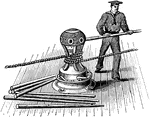Clipart tagged: ‘axle’
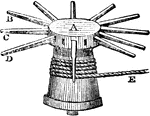
Capstan
"The capstan, in universal use, on board of ships, is an axle placed upright, with a head, or drum,…
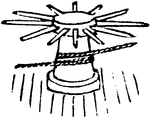
Capstan
"The capstan is a familiar example of this form of wheel and axle. It is used by sailors for warping…
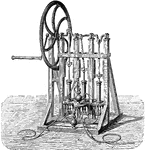
Connected Pumps.
This figure consists of three pumps, the piston rods of which are jointed to three cranks on a horizontal…
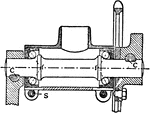
Crank-axle Bearing
"The usual form of crank-axle bearing which has inward-cups and is cup-adjusting. The end of the bracket…
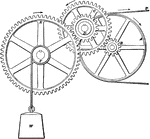
Train
"A combination of wheels and axles, as shown, is called a train. The wheel in a train to which motion…

Langen's Collector
"Langens arrangement is a somewhat similar combination, the cone being made into a bell with perforated…
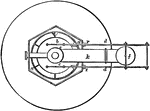
Langen's Collector
"Langens arrangement is a somewhat similar combination, the cone being made into a bell with perforated…
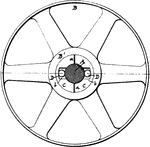
Pulley
A pulley, also called a sheave or a drum, is a mechanism composed of a wheel on an axle or shaft that…

Side Delivery Rake
"Side-delivery rake, a horse-rake in which the rake is suspended between the axle of the pair of wheels…
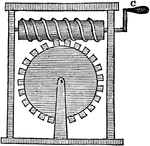
Screw and Wheel
"It is apparent by turning the crank, C, the wheel will revolve, for the thread of the screw passes…
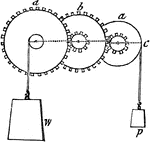
System of Wheels
"System of Wheels.—As the wheel and axle is only a modification of the simple lever, so a system…
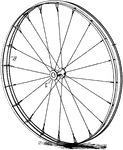
Side View of a Vehicle Wheel
A wheel is a circular device that is capable of rotating on its axis, facilitating movement and transportation.
!["[This illustration] shows a third form of the wheel and axle. Here the axle A is vertical, instead of horizontal. A bar inserted in its head, at the extremity of which the hand is applied, takes the place of the wheel." —Quackenbos 1859](https://etc.usf.edu/clipart/36300/36346/vert_whax_36346_mth.gif)
Vertical Wheel and Axle
"[This illustration] shows a third form of the wheel and axle. Here the axle A is vertical, instead…
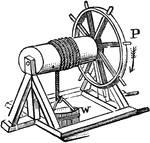
Wheel and axle
"The wheel and axle consists of a wheel united to a cylinder in such a way that they may turn together…

Wheel and Axle
"The wheel and axle consists of two cylinders of different diameters, rigidly connected, so that they…
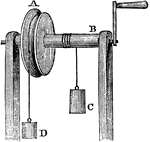
Wheel and Axle
"It consists of two wheels, one of which is larger than the other, but the small one passes through…
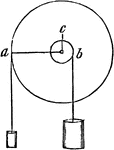
Wheel and Axle
"This figure represents the machine endwise, so as to show in what manner the lever operates. The two…

Wheel and Axle
"To change the direction, it is only necessary that the rope by which the weight is to be raised, should…
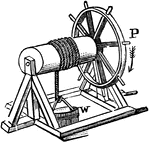
Wheel and Axle with Rope and Bucket
"The wheel and axle consists of a wheel united to a cylinder in such a way that they may turn together…
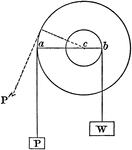
Wheel and Axle
"Considered as a lever, the fulcrum is at the common axis, while the arms of the lever are the radii…

Wheel and Axle with Rope and Bucket
"...the mechanical advantage of this machine (wheel and axle) equal the ratio between the radii, diameters,…
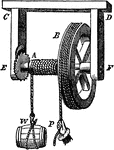
Wheel and Axle
"The wheel and axle is simply a revolving lever of the first kind. One application of the lever can…
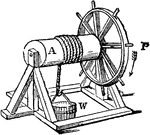
Wheel and Axle with Spokes
"Instead of having a rope attached to it, the wheel is often provided with projecting pins, as shown,…

Fifth Wheel
"Fifth wheel, a horizontal plate, bent to form a whole or part of a circle, placed on the forward axle…
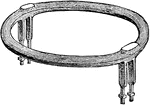
Fifth Wheel
"Fifth wheel, a horizontal plate, bent to form a whole or part of a circle, placed on the forward axle…
!["A still more common form, much used in drawing water from wells and loaded buckets from mines, is shown [here]. Instead of a wheel, we have here a winch, or handle, attached to the axle." —Quackenbos 1859](https://etc.usf.edu/clipart/36300/36345/winch_36345_mth.gif)
Winch
"A still more common form, much used in drawing water from wells and loaded buckets from mines, is shown…
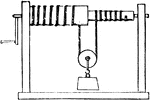
Windlass
"Windlass.—The common windlass for drawing water is another modification of the wheel and axle.…

